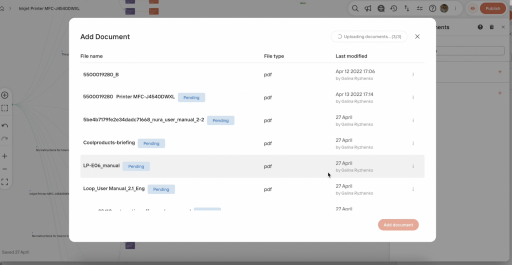Earlier this year, Mavenoid introduced our latest product update — AI Retrieval. For a refresher, AI Retrieval is the Mavenoid tool used for hardware customers to self-service their products. With it, you can increase self-service coverage while decreasing your time to resolution and support team maintenance costs. Not only does it instantly provide results to your customers, but it also enables lasting effects by keeping track of the data to improve future self-service requests from its robust analytics.
Since first launching it, we have worked with both our customers and team to continue to update and optimize the tool to ensure maximum results for complex troubleshooting and general hardware support requests.
Read on to learn more about our AI Retrieval updates that enable your customers to say goodbye to the struggles of locating the proper product documentation for their hardware to resolve their issues and hello to seamless self-service support.
Why did we create AI Retrieval?
Before we discuss the recent updates of AI Retrieval, let's first dive into why we initially created this tool.
To do this, let's walk through a typical process a customer would go through when searching for a hardware manual to self-service their product online.
Typically, when searching for manuals online, they would be directed and then land on a manufacturer's "Downloads" page. Here, they would then have to provide information about their product type, model, and various other tedious information. They would then be presented with a collection of manuals in PDF format, where they would have to sift through dozens of pages to maybe find the right one and then browse it to search and find the answer they need. As you can imagine, this support journey is mundane, frustrating, and, more often than not, ineffective.
In user testing sessions from the Mavenoid product team, we also heard about the dissatisfaction with this process: "I hate PDF manuals - they're hard to search and navigate," "Now they give me a 100-page PDF document that will take me hours to read, and I'm not even sure if there's an answer there..."
Reputable usability specialist Jakob Nielsen spoke about this issue at hand "For our documentation, we use PDFs, but people need a searchable page or an article. We've been doing PDFs for ten years, and now we're wondering how we can make this information more usable and searchable on the site. We get questions every day about documentation, and 99% of the time, we have the answer, but it's buried in a PDF, and people don't want to have to look for it in there. Or, if they search for something we have, it doesn't come up in search results because it's in a PDF."
The issue discussed above leads to bigger problems for both customers and companies.
Specifically, the problem for customers is that there are so many self-service options, yet customers can't get the correct answers. Although the information is out there for customers to self-serve their products (located in manuals, FAQs, and other docs), it is just too hard for them to locate and find in the right document causing a frustrating and tiresome process that most likely won't even lead to a resolution.
For companies, the problem is that achieving the completeness of self-service content is hard and expensive. They have to balance between the impact and completeness of their self-service content and either choose to cover only the most frequent questions or end up spending a lot of resources to answer everything.
These problems resulted in two main questions: how might we put all existing knowledge to work in a self-service solution? And how do we make it friendly for customers and cost-effective for brands?
Enter AI Retrieval.
What does AI Retrieval do?
AI Retrieval is the smart and cost-effective solution to the problems discussed above. It provides answers to customer questions with snippets of relevant info retrieved from existing documents. It lets teams invest time in crafting content for high-frequency scenarios and lets AI take care of the rest.
See it in action and how it works below:
1. Upload one or multiple documents to Mavenoid and let our AI engine process them. Of course, you’re curious about what happens under the hood, right? The engine is interpreting the structure of the document, such as reading order, figures, tables and titles, then identifies pieces of knowledge (these blue boxes in the picture below) that contain “atomic” knowledge of a certain topic.

Now that the knowledge is ready, all you need to do is... turn the Assistant on for your customers. That’s it. No AI training is required.
2. When customers ask a question, the Assistant automatically pulls content from the Flow Builder canvas as well as any uploaded documents.
This search is powered by Mavenoid's Intent Recognition, which uses neural models to find meaning in customers' requests rather than just matching keywords. The customer will receive one or multiple snippets of relevant answers. When choosing one from uploaded documents, they'll also be able to jump to the right page for more information:

Voilà! As you can see, AI Retrieval keeps all the documentation about hardware products searchable and useful and provides the self-service support that your customers need.
Customer success with AI Retrieval
Since launching AI Retrieval, we have already seen success with multiple customers - from major manufacturers of garden equipment, to high-end headphones, and complex ventilation machines. Some of the highlights include:
- Improving coverage of topics in their self-service Assistant by covering questions with quotes from documents. This results in lower escalation rates to live support, as customers are now able to find more answers;
- 6-10 times shorter time-to-answer for customers, compared to searching in traditional “Document Libraries”;
- Launching Mavenoid self-service assistant in hours (not days or weeks) and adding more products to it quickly;
- Getting insights on trending topics covered by AI Retrieval to iterate and create more content on them.
What are the updates?
We are not stopping there! Since first launching AI Retrieval, we have worked with our internal team and customers to continue to update it for optimal performance for hardware support. Below are some of the major updates we've implemented since first launching:
More context from manuals
We've improved the UI, so it is now easier for customers to choose from retrieval results. To add more context to each search result, we now show snippets and breadcrumbs alongside titles. This update makes it much easier for customers to pick relevant matches from manuals.

Multilingual recognition
Besides detecting the accurate part (or parts) in documents, our AI Retrieval now supports multiple languages more accurately.
Bulk upload of documents
You can now add multiple manuals to the flow at once, helping you to implement AI Retrieval faster so you can unleash the full potential of your support documentation.

Streamline Self-Service Support with AI Retrieval
AI Retrieval is your one-stop shop for your customer's self-service support needs. Give answers to thousands of product questions using existing documents with zero effort.
What are you waiting for? Test out the difference with our new and improved AI Retrieval here.
